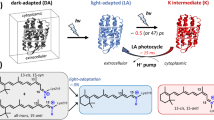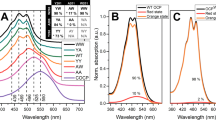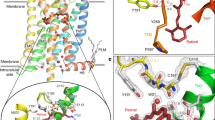Abstract
THERE has been renewed effort1 to test the so-called proton transfer hypothesis (PTH)2 or hydrogen shift1 formulation for the initial photochemical step in vision. This hypothesis proposes an alternative to photochemical cis to trans isomerisation of rhodopsin, while attempting to account for some of the spectral properties of bathorhodopsin (previously called prelumirhodopsin), particularly certain low frequency lines at 920, 877 and 856 cm−1. Spectral lines in this region are not unique to the resonance Raman spectrum of bathorhodopsin3, however, for similar spectral absorption has been found with 11-cis retinal crystals4. The discovery that the batho- intermediate formed by irradiating chicken iodopsin at −195 °C spontaneously reverted to iodopsin at −140 °C by a dark, thermal process5, rather than decaying to lumiiodopsin, also seemed to require such an alternative hypothesis2 (Fig. 1). Although an attempt to demonstrate proton transfer by means of tritium incorporation into the retinylidene chromophore failed2, Fransen et al. apparently now confirm the PTH by their report1 of a small, though significant incorporation of deuterium into retinal. Their newer experiments are similar in design to the earlier ones, differing mainly in their use of deuterium rather than tritium and their method of analysis of labelled retinal. The experiments described here bear directly on the proposed PTH and were performed with an analogue of retinal, 5-desmethyl (dm) retinal: They show that the initial compound produced by irradiating a visual pigment, the batho-intermediate, cannot result from the transfer of a proton from the chromophore to opsin.
This is a preview of subscription content, access via your institution
Access options
Subscribe to this journal
Receive 51 print issues and online access
$199.00 per year
only $3.90 per issue
Buy this article
- Purchase on Springer Link
- Instant access to full article PDF
Prices may be subject to local taxes which are calculated during checkout
Similar content being viewed by others
References
Fransen, M. R., et al. Nature, 260, 726–727 (1976).
Kropf, A., in Processing of Optical Data by Organisms and Machines, Proc. int. School Physics Enrico Fermi (edit. by Reichardt W.,), XLIII 28–43 (Academic, New York, 1969).
Oseroff, A. R., and Callender, R. H., Biochemistry, 13, 4243–4248 (1974).
Cookingham, R. E., Lewis, A., Collins, D. W., and Marcus, M. A., J. Am. chem. Soc., 98, 2759–2763 (1976).
Yoshizawa, T., and Wald, G., Nature, 214, 566–571 (1967).
Kropf, A., Whittenberger, B. P., Goff, S. P., and Waggoner, A. S., Expl Eye Res., 17, 591–606 (1973).
Rotmans, J. P., and Kropf, A., Vision Res., 15, 1301–1302 (1975).
Hubbard, R., Brown, P. K., and Bownds, D., in Methods in Enzymology (edit. by McCormick, D. B., and Wright, L. D.), XVIFIC, 615–653 (Academic, New York, 1971).
Yoshizawa, T., in Handbook of Sensory Physiology (edit. by Dartnall, H. J. A.) 7/1, 146–179 (Springer, Berlin, 1972).
Yoshizawa, T., and Wald, G., Nature, 197, 1279–1286 (1963).
Rosenfeld, T., Honig, B., Ottolenghi, M., Hurley, J., and Ebrey, T. G., pure app. Chem. (in the press).
Author information
Authors and Affiliations
Rights and permissions
About this article
Cite this article
KROPF, A. Is proton transfer the initial photochemical process in vision?. Nature 264, 92–94 (1976). https://doi.org/10.1038/264092a0
Received:
Accepted:
Issue Date:
DOI: https://doi.org/10.1038/264092a0
This article is cited by
-
Photo-tailored heterocrystalline covalent organic framework membranes for organics separation
Nature Communications (2022)
Comments
By submitting a comment you agree to abide by our Terms and Community Guidelines. If you find something abusive or that does not comply with our terms or guidelines please flag it as inappropriate.



